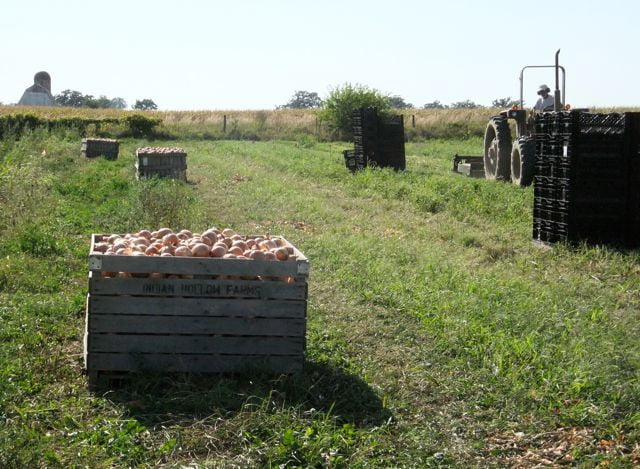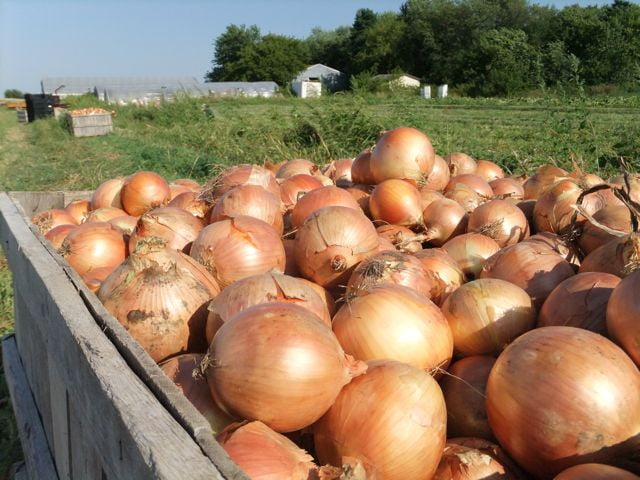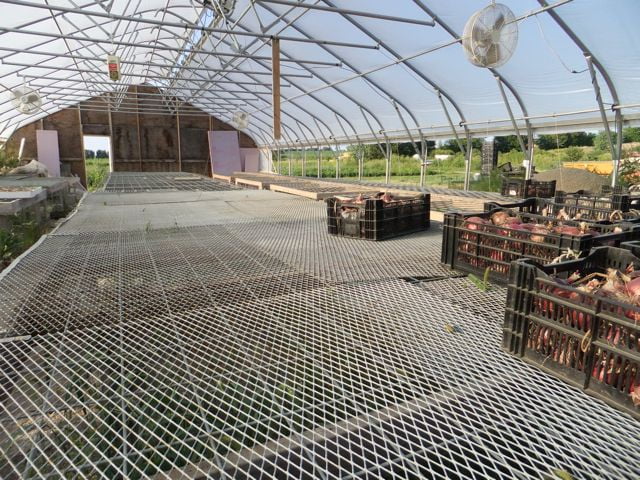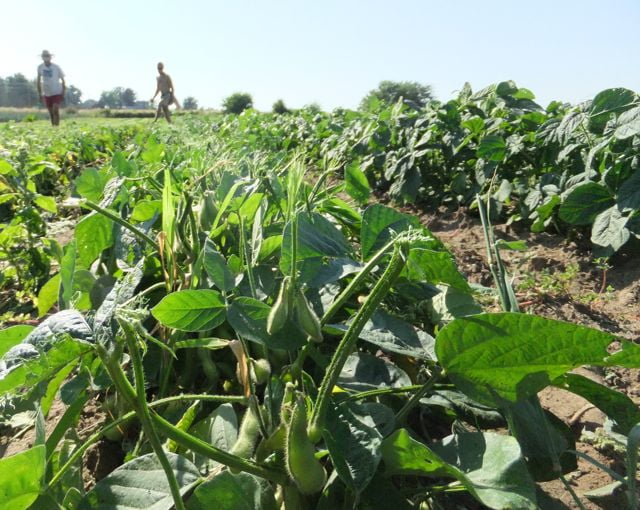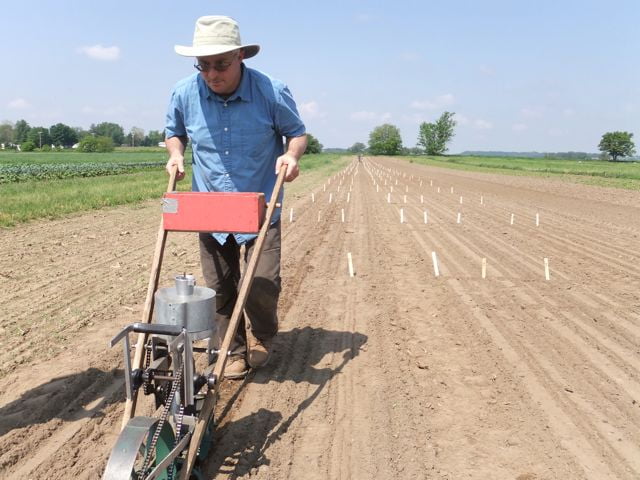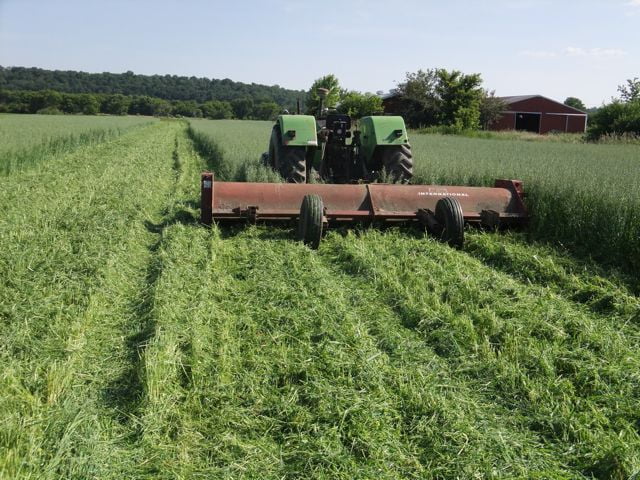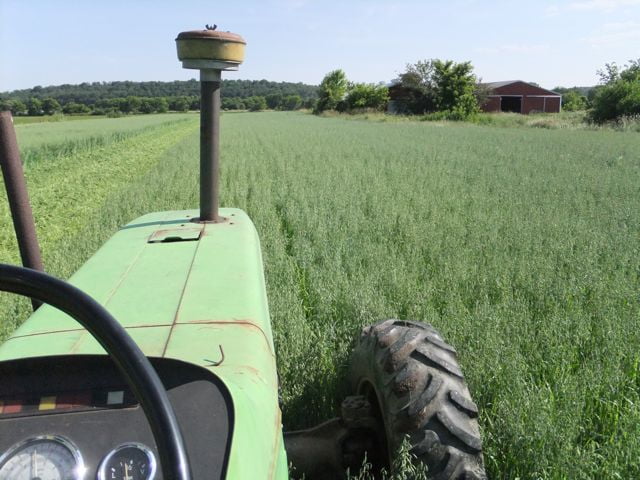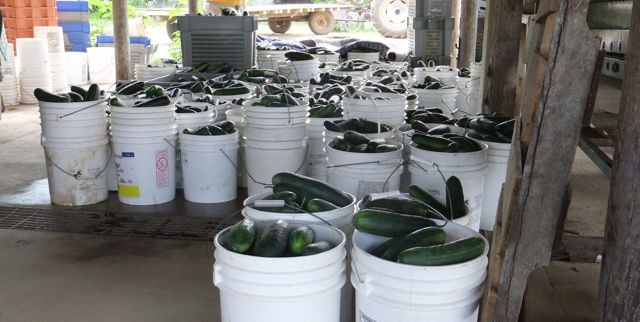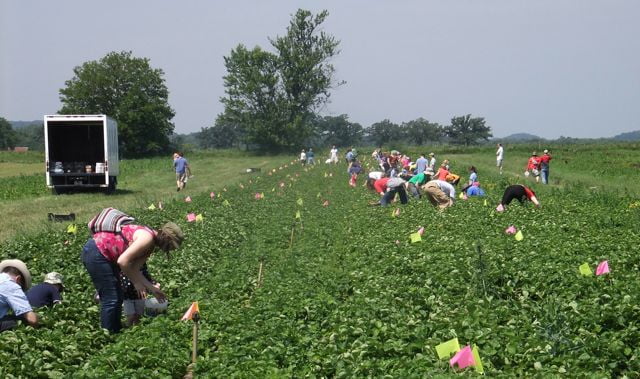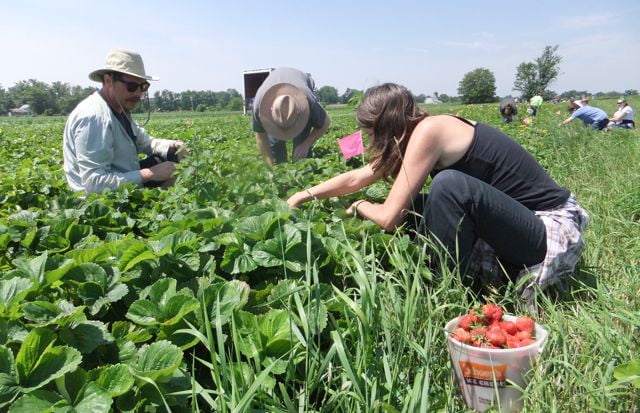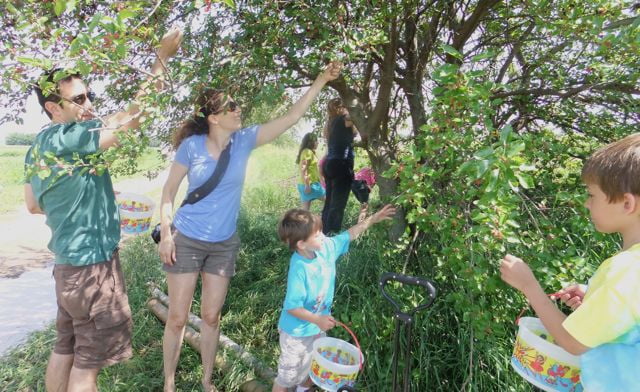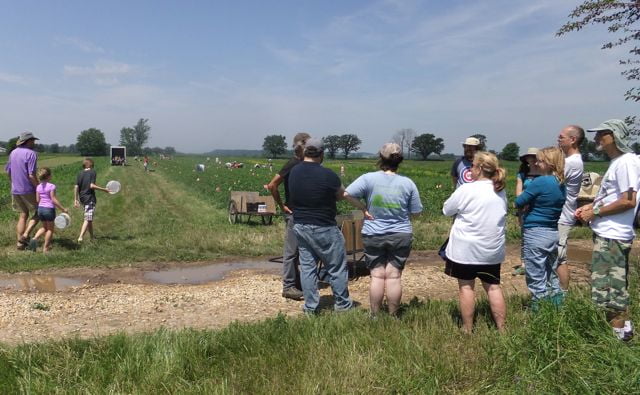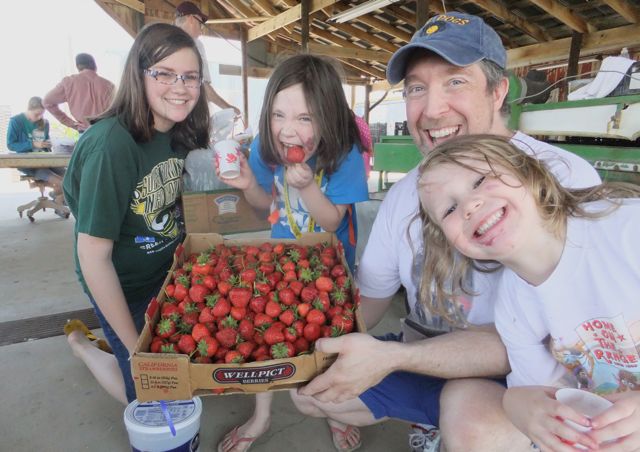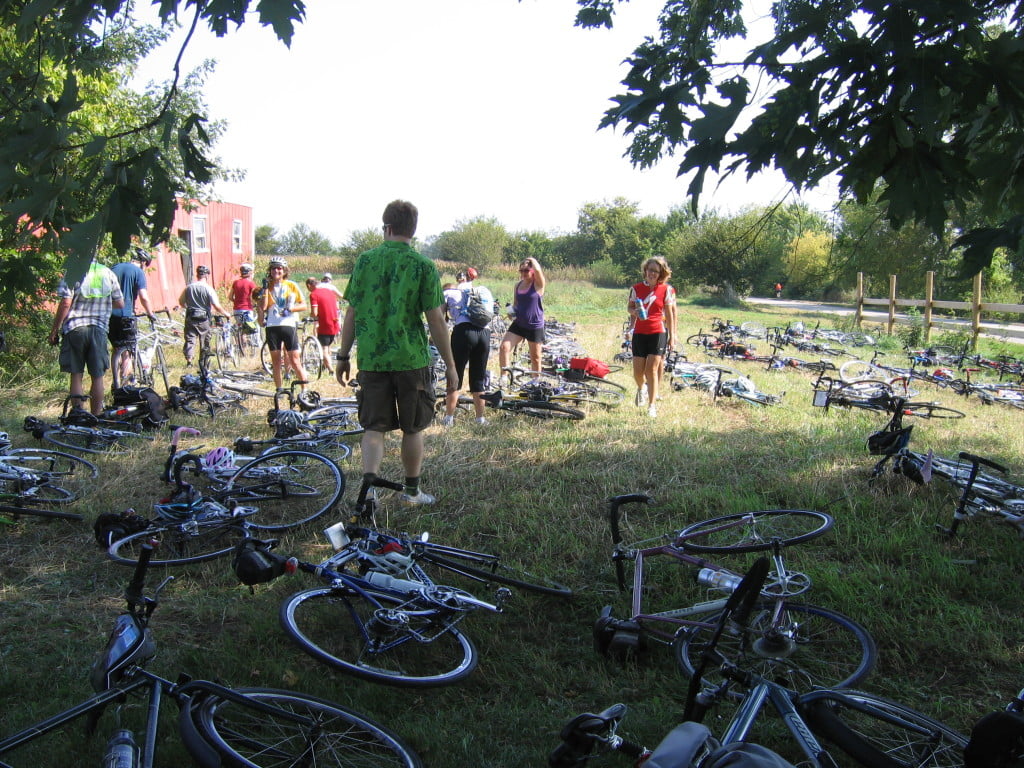Blog
Don’t need medicine to cure these onions
- On: August 28, 2013
 0
0
We found two ways to save effort this week. It was an unusually hot and busy week, and both changes were welcomed by our work crew.
The recent dry weather has allowed us to cure our onions in the field instead of hauling them to the greenhouse. Their growth is finished and the leaves have dried down. At harvest, we pull the onions out of the ground and leave them on the soil surface for a few hours to wither the roots. Usually, we pile them into shallow black crates, then haul them into the greenhouse to dry completely, then carefully transfer them into big wooden bins.
Onions are heavy, right? Skipping the greenhouse step saved so much effort. The onions look good. I hesitate to write that after 80% of the crop rotted last year. Let’s keep our fingers crossed.
After curing for several days in the field, the onions went straight into wooden bins for storage. On the right side of the field are stacks of plastic crates for gathering onions during harvest. Steve mows weeds now that the onions are collected.
The yellow onions sized up nicely this year. We’ll send this type after the shorter-season Walla Walla and white onions are done.
The greenhouse is almost empty right now. Usually every bench is filled with curing onions.
For our second innovation this week, Steve mowed the tops off our edamame plants before harvest. We usually chop them off with a machete. The pods set beautifully in a dense clusters at the base of the plants, allowing Steve to mow the leaves without damaging the pods.
Each simple change was appreciated by our work crew during a hot and busy week.
Edamame plants just before harvest. You can see the mowed, feathered tops of the plants in this row. The row to the right is unmowed.
Veggie List and Veggie Notes
1 melon (watermelon OR crenshaw OR honeydew)
sweet corn, probably 6 ears
edamame (edible soybeans), 1 bundle
slicing tomatoes, 5 lb
Walla Walla onions, 1 or 2
Romano beans, 0.75 – 0.85 lb
bell pepper, 1
cherry tomatoes, 1 pint
basil, 2 sprigs
One site will get an heirloom tomato.
Next week’s box will probably contain melon, sweet corn, tomatoes, peppers and more.
Melon – Most members will get a red watermelon this week but a few sites will receive crenshaw or honeydew. Here’s some extra info on those two types. Both are specialty melons that Steve tinkers with each year so our harvests are limited.
Crenshaw melons (Outpost or Basics co-ops; oblong with yellow rind and pale orange flesh) – These melons look like muskmelons inside but have a different flavor. They’ve been excellent this year. Ready to eat.
Honeydew melons (Basics only; white rind with pale green or white flesh) – These melons need to ripen at room temperature for two days before eating.
Edamame (bundle of stems with leaves and pods) – These edible soybeans are a treat. Pull the pods from the stem and wash well. It helps to submerge the pods and rub them together. Boil in water until the pods have split and the beans are quite tender. Season with salt and pop the beans out of the pods into your mouth. This Japanese specialty is becoming more and more popular in the USA. Storage: Remove the pods from the stems promptly and refrigerate.
Cherry tomatoes – We picked a variety of colors but everyone will receive some pink or some Black Cherry tomatoes. These two varieties are our favorites right now, so we wanted to share with everyone.
Heirloom tomatoes (large tomato that’s not in the bag with other tomatoes) – The heirloom tomatoes are just beginning to ripen. If you receive one this week, please handle it gently. These fragile beauties bruise easily. You might have to ripen your heirloom tomato at room temperature for a day or two. Don’t let it get overripe.
Farm news and farm photos
- On: August 21, 2013
 0
0
We’re in the thick of our summer work. I wish we were finished planting but Steve is still nurturing new seedings out of the ground. It is tricky to keep young seedlings moist during dry weather. Several critical carrot and winter radish plantings failed and needed re-seeding. We are grateful that we can get replacement seed shipped to us quickly. The latest radish planting is coming up nicely. It’s a relief. Otherwise, our crew is busy with harvests and weeding. All our crops feel heavy right now: melons, tomatoes, onions. Steve notices the melons the most.
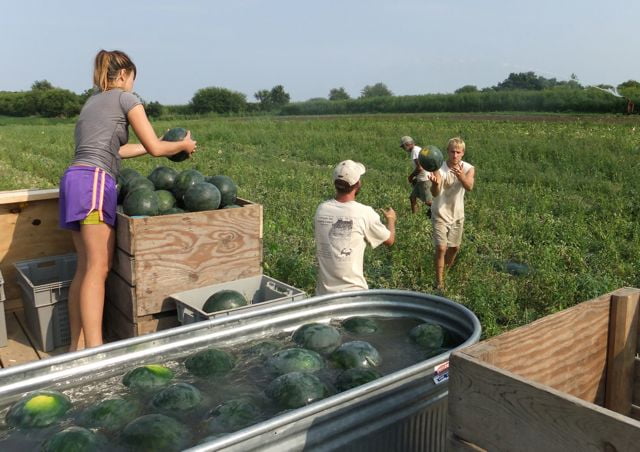
It takes a crowd to harvest watermelons.
Steve (furthest in back) carefully chooses ripe melons. He tosses to David, who tosses to Kyle, who tosses to Brianna on the wagon, who washes the melons. Steve is 65 years old but in great shape. Nonetheless, he’s already asleep because he picked 12,000 lb of melons this week and expects to pick another 4,000 lb tomorrow. You can see white spray from the irrigation gun in the top right corner of the photo above. Steve and the others were at the edge of the irrigation mist during melon harvest, the perfect place to be on a hot day.
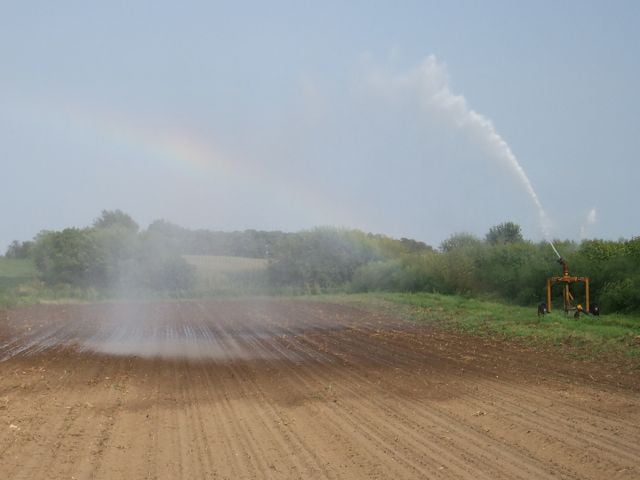
Traveling irrigation gun with rainbow.
We’re back to irrigating all our crops. There’s been little rain for 8 weeks. We coasted for a while on the heavy rains that came in June, then cool weather protected the plants from stress for a few more weeks. At this point our crops will not grow without extra water. We are counting on our strong irrigation well which pulled us through last year’s drought.
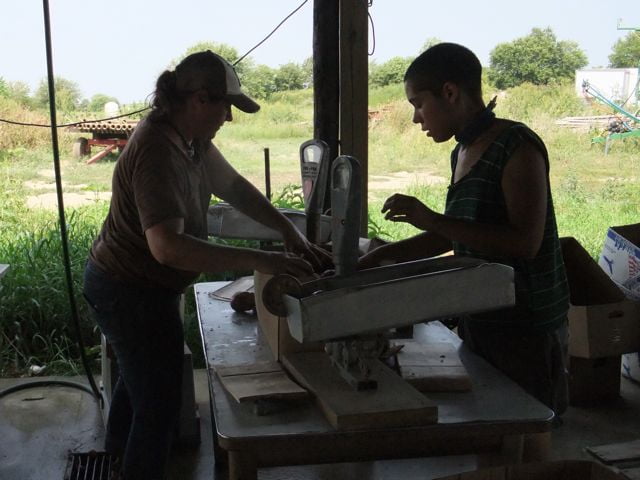
Blue and Boi use tip scales to weigh potatoes for the CSA boxes.
Our outdoor packing shed is another good place to be during hot sunny days.
Veggie List and Veggie Notes
1 melon (watermelon OR muskmelon OR crenshaw)
sweet corn, about 5 ears
“new” red potatoes, 3.25 – 3.5 lb
mixed slicing and plum tomatoes, 3 lb
white onion, 1 large
Romano beans, 1.1 lb
red Italian frying peppers, 2 or 3
#2 grade red bell peppers, 0 or 1
green leaf lettuce, 1
parsley, 1 bunch
You will receive 1 or 2 squash if we can fit them in your box.
Next week’s box will probably contain watermelon, tomatoes, peppers, onions, basil and more
Melons – We grow a variety of different melons and will continue to rotate the types among the pick-up sites. Red watermelon are traditional seeded varieties. Yellow watermelons are smaller with very sweet flesh and a softer texture than red watermelons. You know our muskmelons by now – we’ve sent them for several weeks because they’ve been quite tasty. One site (Evansville) will get crenshaw melons this week. These look like muskmelons but have a different flavor.
“New” red potatoes – The potatoes are from Chris Malek of Malek Family Stewardship Farm. They were harvested young enough that the skins have not set but (unlike most new potatoes) they were grown to full size. The skins are fragile so handle carefully while cooking. I boiled a pot until just cooked and they made fabulous potato salad. Chris advises that you refrigerate these potatoes because they lose moisture very readily at this stage. Don’t overcook them.
White onion – We’re sending white onions for a change from Walla Wallas. The white onions are more pungent than Wallas and have low moisture so they will fry, although they do not fry as well as yellow storage onions.
Romano beans – Steve asked me to write that the Romano beans are at full maturity and will hold up to a braising recipe. These are lovely beans, nicer than the batch we sent two weeks ago.
A fresh pair of hands
- On: August 14, 2013
 0
0
We hired a new worker to help Steve with his varied tasks, especially machinery repair and tractor work. Larry comes to us with broad experience, having run his own small business. He wasn’t scared off by our motley used equipment. He and Steve share a sense of humor. Larry bought a $6 set of feeler gauges for fine-tuning engines. Steve took the tool in his hands and said, “These are nice but I don’t know how to use them if they aren’t rusty.” They both cackled for a while. It was a guys-who-fix-things joke.
Steve knows how to do everything. He just can’t get it all done himself so he needs Larry’s help. Of course, all our employees fit that description. We have a long list of projects lined up for Larry.

Steve and Larry have this job under control.
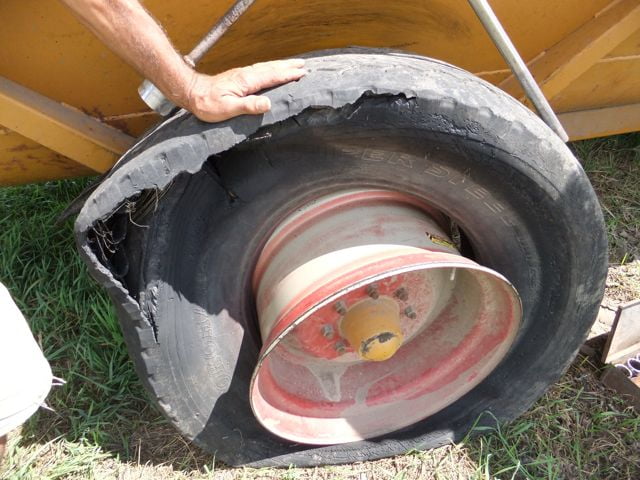
Steve says this tire is currently the worst of the 160 tires we have on our farm.
When Should You Refrigerate Tomatoes?
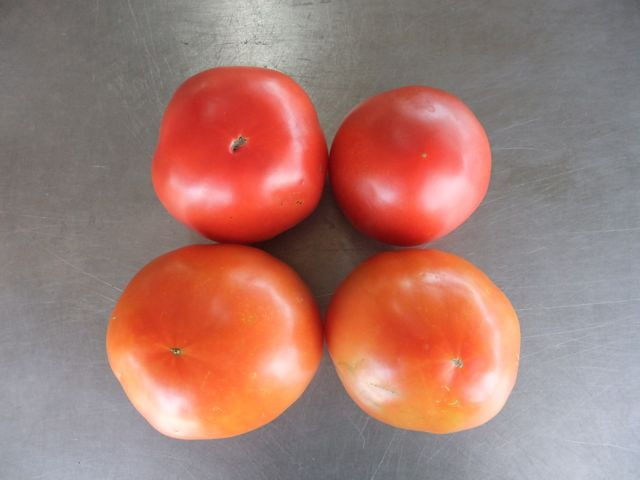
Ripe tomatoes (top) and less-ripe tomatoes (bottom).
As usual, we have packed a mix of ripe and less-ripe tomatoes so you can stretch them through the week. The top two tomatoes in the photo are ready to eat. The bottom tomatoes need to ripen at room temperature for a few days. Put on your counter or keep in a brown paper bag.
Tomatoes retain their best flavor and texture when stored at room temperature, no lower than 55oF. However, you should refrigerate your tomatoes if they are fully ripe and you don’t expect to eat them right away. It is better to sacrifice a little flavor and texture than lose your tomatoes to rot. Also, fully-ripe tomatoes are less sensitive to chilling injury.
#2 Grade Red Bell Peppers
I write about pepper grading every year. Returning members can say “yeah, yeah” and skip ahead. New members, please read.
Many of the red bell peppers we send in the CSA boxes will be our #2 grade. We do this to avoid waste and to deliver good value to our CSA members. The #2 grade peppers are excellent eating quality, but are not quite pretty enough to sell to stores. As a result, we place a much lower value on these peppers. This allows us to provide generous amounts of red bell peppers over the course of the season, about three times the amount we could provide if we only gave #1 grade. We feel this is a good exchange, even if it means you occasionally open a pepper and find that it needs trimming. Here are the reasons that peppers are downgraded from #1 grade to #2 grade:
1. They may have a minor blemish, or
2. They may have minor insect damage, or
3. They may be very ripe and beginning to wrinkle. (These are especially sweet and delicious as they are fully ripe. These cannot be sold to stores because their shelf life is short. You will find that the texture is less crisp than a #1 grade pepper, but the flavor more than makes up for it.)
4. They might be partially red and partially green.
5. Others are just too small.
The eating quality is fine (or excellent) for all these #2 peppers. We throw away all peppers that we suspect have rot inside (although one may occasionally slip through in either #1 or #2 grade.) Today’s peppers are #2 grade.
Veggie List and Veggie Notes
muskmelon, 1
sweet corn, 6 ears
slicing tomatoes, 4 lb
green leaf lettuce
#2 grade bell peppers, 2, red or ivory
Walla Walla onions, 1 or 2
garlic, 1 head
oregano, 1 small bunch
You will get one or two of these items: broccoli OR eggplant OR cucumbers/pickles OR cherry tomatoes
Next week’s box will probably contain melon, tomatoes, peppers, lettuce, sweet corn, onions, parsley and more.
Muskmelon – Don’t worry if you haven’t received a watermelon from us yet. We send more muskmelons at the beginning of melon season while their flavor is at its best.
Garlic – The garlic is from John Hendrickson of Stone Circle Farm. John supplies our garlic bulbs and scapes.
Broccoli – These heads are from a spring planting that drifted away from its usual schedule. That can happen in hot weather. It’s so unexpected to have broccoli in mid-August. The uneven heads are typical of summer broccoli. Steve says you might need to trim a bit, and to watch for green “worms” hidden in the heads. Submerge the broccoli in water, shake, and they will float free. I’m making it sound horrid but it’s actually nice broccoli.
Our hidden beach
- On: July 31, 2013
 0
0
I write often about our farm work, but rarely about the fun of living on a farm. The previous owners of our farm created a sand pit. They sold sand for road construction, leaving an open bowl-shaped pit in a hillside. When we bought our farm, I viewed it as an ugly scar on the landscape and plotted to bulldoze it flat. Wow, I was so wrong. It has become a favorite place for our family. Our children find it endlessly interesting. It was a giant sandbox when they were young, then a terrifyingly steep sled run, now a sheltered and exotic fire pit. For Steve and me, it is a direct look at the glacial till that underlies our farm.
I appreciate the pit on cool fall days. The west-facing slope catches warmth from the setting sun. We picnic there in short-sleeves but would need snow jackets up above. I asked our son what he likes best about the sand pit.
“It’s a good place to find fossils.”
“There’s no dirt – it’s all sand and gravel and there are even different types of sand.”
“It’s a mini desert.”
It is a child’s paradise. We remember the birthday party when a pack of kids soaked themselves under the irrigation, then ran to the sand pit to roll in the warm sand. They looked like sugar doughnuts. This is cheap fun.
Farm News.
• Email brown-out. Remember, I will be away from the farm next week. Please limit communication with us during August 2 through August 12. Contact me no later than 8 a.m. this Friday to cancel a box, ask questions, etc.
• I will deposit post-dated August 1 checks on August 2.
• Carrots. We are working intensively to establish our fall carrot crop. Steve is in the midst of replanting two acres. He planted those fields just before the hot spell and the seeds did not germinate well. This is our last chance to replant. Any later and the carrots will not be ready to harvest before winter sets in. The weeds are growing quickly. Our crew battles them every day. We will be relieved once the new fields are well established. Have you noticed that carrots are missing from the CSA boxes? We often deliver carrots in late July but lost the early planting to weeds during a wet spell in May. Look for carrots from us in about one month.
• The crew’s work is very straightforward right now. It’s all harvesting and weeding. We seeded our last flats of transplants, fall greens like Yukina and mizuna to fill the CSA boxes in November. Those plants will go in the ground in late August, then our greenhouse work is done for the year.
• Spotted wing drosophila (SWD) has appeared in our raspberries again this year. This new fruit fly pest devastated Wisconsin’s fall raspberry crop last year. Once again, it has shown up across the state. Steve has begun weekly applications of organic pesticides. We have recognized the SWD earlier than last year, and are hopeful about limiting the damage. We are optimistic enough that we trellised the brambles this week for easy picking. Our farm is participating in a UW monitoring program to track SWD. Ironically, our children were the first to find the bugs, just like last year. They are observant kids with little fingers, lots of time and a love of raspberries. They spend a lot of time in the berry field.
Veggie List and Veggie Notes
Sweet corn, about 7 ears
Muskmelon, 1
Lacinato OR green kale, 1 bunch
Green bell pepper, 1 or 2
Walla Walla onions, 1 or 2
Zucchini or summer squash, 2 squash
Cucumbers, 2
Slicing tomatoes, about 1 lb
Cherry tomatoes OR eggplant OR green beans
Next week’s box will probably contain watermelon, tomatoes, cabbage, peppers, onions, Romano beans and more.
Sweet corn – Be prepared: some tips will need trimming. Otherwise, this is an excellent, tasty batch of corn.
Email brown-out
- On: July 24, 2013
 0
0
I am taking our children to visit family. We ask that you limit communication with us from August 2 through August 12. Please contact us no later than 9 a.m. on August 2 to ask questions, cancel a box, etc. This is an email brown-out, not black-out. Steve will check my emails but won’t have much time to respond. I’ll be back and ready to communicate on August 13. Thanks for your help with this. Beth
I will deposit August 1 checks on August 2. Many of you paid with checks post-dated to August 1. I will deposit the checks on Friday August 2.
Pat’s recipe featured on NPR.
Our menu chef Pat Mulvey of Local Thyme received an exciting honor this week. Her Ensenada Slaw recipe and the charming story of its discovery were featured on NPR’s “All Things Considered.” Go here to listen to the radio clip and to vote for her recipe. Pat’s recipe is in competition with three other summer recipes featured in short radio segments this week. She’d love the votes and, honestly, it’s the best recipe of the bunch. Keep this dish in mind; we plan to send cabbage again in the next few weeks.
First melons

From left, Noah and Michael toss muskmelons at harvest. It’s the best way to get the melons from the field to the wagon.
We’re glad to have melons to harvest. During the blazing heat last year, the first week we had melons for everyone was July 19. This year, they are ready on July 25. Isn’t that interesting? The weather was so different, but the plants compensated. All our squash-family crops have stayed on schedule despite the cold spring, probably because they were sheltered under row cover. That’s melons, zucchini, cucumbers, pickles, winter squash and pumpkins.
Veggie List and Veggie Notes.
Muskmelon OR watermelon
Green beans, 2 lb
Sweet corn, just 1 ear
Sugar snap peas, 3/4 lb (last of the season)
Cherry tomatoes OR slicing tomatoes
Italian frying peppers, 3
Cucumbers, 3
Pickling cucumbers, a handful
Mixed zucchini and summer squash, about 2 lb
Walla Walla onions, 1 or 2
Basil, 1 or 2 large sprigs
One site will receive globe or Japanese eggplant
Next week’s box will contain sweet corn, melons, green beans, tomatoes, peppers, onions and more.
Sweet corn – We realize that one ear of corn is a tease! Well, they are ready so we are sending them. We suggest you cut the kernels into any cooked dish during the final minutes of cooking. It’s the only fair way to share the one ear. There should be lots of sweet corn next week.
Pickling cucumbers (small cucumbers with thin skins) – These are excellent in salads because of their think skins. Children (at least ours) love them as snacks.
Italian frying peppers (green or red, long, slender) – These sweet frying peppers are special. They contain less moisture than normal bell peppers and therefore can be fried in a small amount of oil, preferably over high heat. They are unbelievably fragrant while cooking. If you attempt to fry normal bell peppers, they release juices and you end up sautéing them instead. Frying peppers are also excellent raw.
Here are several things to watch for on the peppers this week:
– Some peppers have minor sunscald, which appears as a white patch on one side of the pepper. You can eat or cut around this area. Sunscald abates later in the year, as the growing foliage shades the developing peppers.
– Blossum end rot. Many of the Italian peppers have a black tip. This is related to calcium uptake in the plants. Again, just trim off the affected part.
Japanese eggplant (only one site will receive this week) – These eggplant are long, slender, and dark purple. The skin is thinner on this type than on globe eggplant. These are traditionally left unpeeled in Asian cooking, and are often cut diagonally. When cutting lengthwise slices of Japanese eggplant, I find it useful to remove a little skin from the outside slices, as they grill or sauté best when the flesh is exposed.
Subversive carrots
- On: July 18, 2013
 0
0
This season, we are hosting a large carrot variety trial by UW/Horticulture professor Irwin Goldman and graduate student Claire Luby. We try new vegetable varieties each year. Steve evaluates how well the varieties grow, while I judge their sweetness and flavor. This trial, however, involves much more than taste evaluations.
Irwin and Claire have a radical plan. In his years as a vegetable breeder, Irwin has observed an alarming loss of traits that used to be available publicly. As companies patent specific plant traits, they become unavailable for public breeding programs. For example, breeding for red carrots used to be in the public domain. Now that trait has been patented, and breeders are forced to license the patented material or forgo breeding carrots for red color. Red color in carrots is a novelty trait; other patented traits are much more valuable.
In planting this large trial, Claire and Irwin hope to identify unpatented sources of diversity. Their ultimate goal is to develop “open source” breeding lines for release with the stipulation that any varieties developed from their lines must remain unpatented. Irwin is a participant in the Open Source Seed Initiative (OSSI), a group of scientists working to develop open-source seeds for a variety of crops. Irwin told us “The open source model works on the principle that you can receive the seeds if you agree not to tie them up, but you can also use them in breeding, crop production, or even sell them. We hope this will also foster some additional breeding activities by gardeners and farmers who may want to save their own vegetable seeds and do a little breeding on the side.” This recent article (see p. 28) describes OSSI, as well as Irwin, Claire and others’ groundbreaking efforts to breed crops specifically for organic farming systems. These are big ideas that can help farmers everywhere.
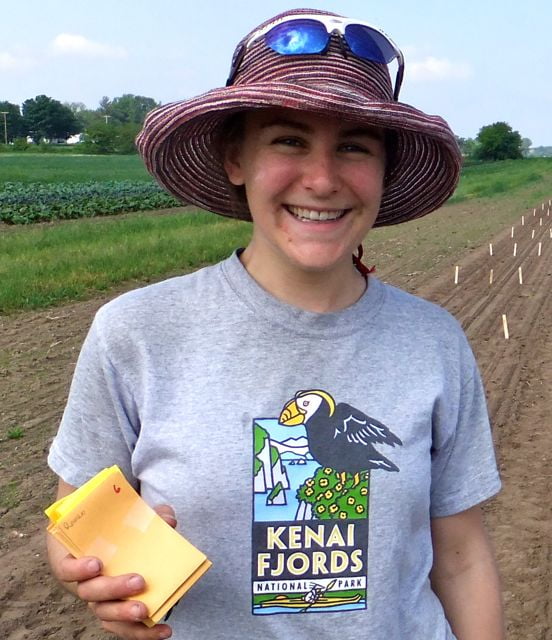
Grad student Claire Luby holds a few of the 150 carrot varieties she cajoled from companies and breeding programs across the USA.
We appreciate the chance to participate in this effort, and the opportunity to evaluate such a wide range of carrot varieties. We almost always host trials when asked by the university. Vegetable farmers lack the financial clout of the corn, soybean or potato industries. Hosting trials is one way we support scientists researching organics or vegetable farming.
Veggie List and Veggie Notes. This week’s veggies show effects from both the recent wet weather and the recent dry weather. Pretty crazy. We’re harvesting during hot weather, so we suggest that you eat your lettuce and broccoli soon. Hot weather at harvest shortens their storage life. If your leafy vegetables seem wilted this week, submerge in a tub of cold water for 15 minutes to help crisp them up. This is a good technique for lettuce, greens, herbs and broccoli.
Cabbage, 3 to 4 lb
Sugar snap peas, 0.8 lb
Lettuce, red leaf or red bibb
Cucumbers, 4 or 5
Mixed zucchini and summer squash, 2 to 2.5 lb
Green OR purple bell pepper, 1
Curly OR flat Italian parsley, 1 bunch
Walla Walla onion, 1
Broccoli (1 head) OR kohlrabi
A few sites will receive 2 Japanese eggplant this week.
Next week’s box will probably contain green beans, cukes, zukes, and more. There might be melons to share too!
Cabbage – This ia a nice salad-type that we grow in summer. It has thinner, more tender leaves than the usual green cabbage. Great in salads and slaws but can also be cooked.
Lettuce – We can still grow lettuce during hot weather as long as we harvest it young. Please ignore the leaf spotting on some heads – it is a remnant of the wet spell that is now fading into distant memory.
Broccoli – Eat soon. Broccoli harvested in hot weather (and stored with ethylene-producing summer crops) does not store well.
Farm news & photos
- On: July 10, 2013
 0
0
The CSA pick-ups went smoothly last week despite the unusual July 4 schedule. Good job, folks!
For us, July 4 means fireworks and carrot planting. Steve begins planting our fall carrot crop on July 3, weather permitting. In a good year, the carrot fields are all planted within two weeks. In a challenging year (like 2012) we replant multiple times to get a good stand of carrot seedlings. Hot dry weather will damage the seedlings despite irrigation. Heavy rains crust the ground and the seedlings can’t emerge. I’ll keep you posted about this year’s plantings.
The time-consuming strawberry harvests are done. Now we are busy harvesting early summer crops like peas and cucumbers, and transplanting winter storage crops such as cabbage. We’re working hard to weed and maintain our summer crops.
Beth
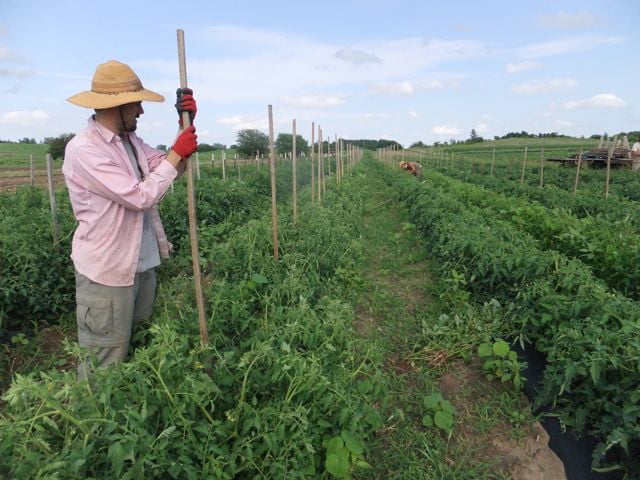
Alex and Boi place stakes in the tomato field. Soon we’ll weave string between the stakes to support the plants.
Veggie List and Veggie Notes.
Strawberries, 1 pint
Romaine lettuce
Walla Walla onion, 1
Broccoli, 1 large or 2 medium heads
Fennel, 1 bulb with luxurious fronds
Cucumbers, 4 or 5
Sugar snap peas, 1.1 lb
Mixed zucchini, patty pan and summer squash, 3 lbs.
Basil, 1 or 2 sprigs
Next week’s box will probably contain cabbage, cucumbers, peas, Walla Walla onion, lettuce & more.
Fennel (large vegetable with a fat bulb and lacy fronds) – Fennel is a ‘swing vegetable’; it can be used raw or cooked. Clean well and slice as thinly as possible for use in raw salads. It is good simply prepared with olive oil, lime or lemon juice, salt and shaved parmesan cheese. Cooking softens and sweetens fennel, and mellows its anise flavor. Both the bulb and leaves are edible. Here are ideas from Alice Water of Chez Panisse about how to use fennel: ‘It’s strong anise characteristic seems to suit fish particularly well. … We use fennel all the time. We add the feathery leaves to marinades for fish and to numerous salads, sauces and soups and we use them as a garnish, too. … The bulbs are sliced and served raw in salads in various combinations with other vegetables, parboiled for pastas; caramelized and served as a side dish; braised whole; or cooked in vegetable broths & fish stocks.”
Walla Walla onions – These are sweet onions, like Vidalias. Wonderful raw or lightly cooked. The crew walked the field to find the biggest onions for today’s box.
Caesar Salad, safely made with cooked egg yolks.
I gave up Caesar salad years ago. Who wants to eat raw eggs? The beautiful Romaine lettuce made me long for Caesar salad, so I researched ways to make it safely. Food scientist Harold McGee has developed a method that works. We add snap peas for crunch instead of croutons. Many Caesar salad recipes call for 10 Tbsp. oil, but you can reduce the oil to 6 Tbsp. and the dressing still works.
Harold McGee’s method to sterilize egg yolks
Use a clean fork at each step to avoid re-contaminating the cooked yolks.
2 large egg yolks
1 & 1/2 tsp. water
1 tsp. lemon juice
Mix the ingredients in a clear glass bowl and beat together with a fork. Cover the bowl and microwave on high power until the mixture bubbles (about 45 seconds). Uncover and stir with a clean fork. Cover and microwave until it bubbles again (about 20 seconds) and let it bubble 5 to 10 seconds more. Stir again with another clean fork. Let cool. The mixture will be custard-like.
Caesar Salad
2 large eggs yolks, cooked as described above and still in the clear glass bowl
2 – 3 Tbsp. lemon juice
1 tsp. Worchestershire sauce
1 clove garlic, grated
2 tsp. anchovy paste
5 Tbsp. olive oil (or less)
5 Tbsp. canola oil (or less)
3/4 cup grated Parmesan cheese
black pepper
1 head Romaine lettuce, cut into 2-inch pieces, washed and carefully dried
croutons and/or snap peas
1. Add the lemon juice, Worchestershire sauce, garlic and anchovy paste to the cooked egg yolks. Stir together with a fork. Let stand 5 – 10 minutes.
2. Slowly drizzle the canola and olive oils into the mixture while beating with a fork to emulsify. Stir in 1/2 cup Parmesan and black pepper to taste.
3. Mix the dressing with the prepared Romaine and croutons (or peas) in a large bowl and toss to coat. Taste and add the remaining 1 Tbsp. lemon juice if needed. Sprinkle remaining Parmesan over top. Serve.
Virtual u-pick tour
- On: July 02, 2013
 0
0
Final reminder: All “Thursday” sites will get their boxes on Wednesday 7/3 due to the July 4th holiday. Friday members are unaffected and will get their boxes on Friday as scheduled.
Here are photos from the u-pick on Sunday, for those who could not attend. The weather was perfect. Steve and I really enjoy the u-picks. It’s a chance to meet members and share the farm.
The berry field.
Strawberry picking was the main attraction.
The mulberry trees are loaded, even on the lower easy-to-reach branches.
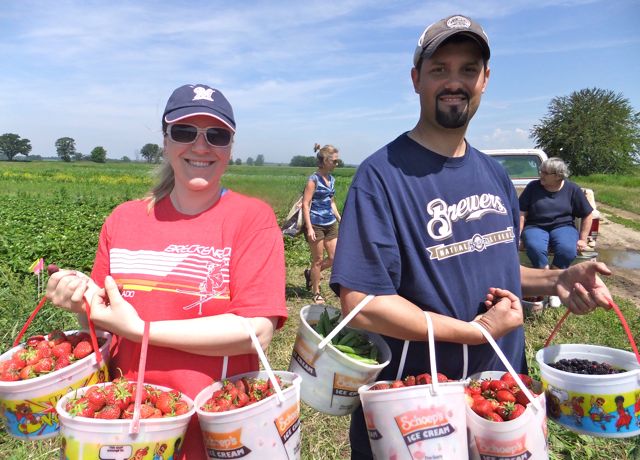
These folks enjoyed all three u-picks: strawberries, shell peas and mulberries.
Steve (in black shirt at center) starts the farm tour while berry picking continues.
There’s a happy family.
Thanks to everyone who let me post their photo here.
Veggie List and Veggie Notes. Local Thyme will have their menus ready early this week.
Strawberries, 1 quart
Sugar snap peas, about 2/3 lb
Snow peas, about 1/2 lb.
The two types of peas are combined in one bag, with snow peas on top.
Napa cabbage, large, about 3 lb
Cucumbers, 2
White salad turnips, 1 bunch
Zucchini/summer squash, 2 to 3 lb
Scallions, 1 bunch
Basil, 1 sprig
Next week’s box will probably contain peas, cucumbers, cabbage, lettuce, strawberries (maybe) and more.
Strawberries – The berries are ripe. Eat them right away.
Napa or Chinese cabbage – This is the large pale green head. This Asian vegetable can be eaten raw in salads, or cooked in simple stir-fries. Napa stores very well. Cut off wedges as needed and keep the rest covered and refrigerated, and it will keep for several weeks. Peel off the outer layer and it will be ready to use. Here are a few preparation ideas from the ‘Asparagus to Zucchini’ cookbook.
– Chop raw napa into green salads.
– Substitute napa in traditional coleslaw.
– Chinese cabbage cooks quickly. Steam 3-5 minutes, or until leaves are wilted down but remain slightly crisp.
– Substitute napa cabbage for common cabbage in recipes, but reduce the cooking time by 2 minutes.
– Napa cabbage is the main ingredient in egg rolls. Try making an egg roll mixture to eat as a cooked side dish instead of preparing time-consuming egg rolls.
Snow peas (flat pea pods) – These are excellent stir fried or in raw salads. The thicker pea pods will usually have two strings along the edges. Remove them when you snap the stem off.
Scallions – These green onions are large but remain quite tender. Use raw or for cooking.
Basil (stem with frilly green leaves) – This is the variety ‘Napoletano.’ The leaves are larger and more frilly than most basils. We like this variety because the its leaves remain tender and flavorful even as the plants mature. Basil will blacken if stored in the refrigerator. It is best stored at room temperature, with the cut ends in water, for example in a glass or teacup. You will receive one or two sturdy stems this week. This are from the first pruning to shape the plants.
Camaraderie
- On: June 26, 2013
 0
0
A new employee remarked on the camaraderie among the work crew. That’s how we get through difficult jobs. Yesterday we sent everyone to pick peas in a muddy, muddy field. People sank ankle-deep into the mud. By this morning, everyone had a funny story to tell about the experience. Steve and I were relieved – we knew it had been a difficult task. But it was OK because everyone was together, it was warm, the rain had stopped, and the peas were in beautiful shape and therefore were enjoyable to pick.
It was a dry month for us – until Friday. Surprised? The storms drenching southern Wisconsin slipped by our farm until Friday. It was eerie to watch them on the weather maps. It’s been so dry that we began irrigating two weeks ago. We can put the irrigation equipment away for a while. We got six inches of rain in six days. That’s plenty. We hope it will stay dry for the next week to protect our strawberry crop. The berries we picked this week are quite soft because of the rain. Plan to eat them right away, as they will not store well.
Strawberry U-Pick
Check this week’s email for u-pick information.
Reminder: We will make our Thursday deliveries on Wednesday July 3 next week. Friday deliveries will be on July 5, as scheduled.
Veggie List and Veggie Notes
Strawberries, 2 quarts
Sugar snap peas, 1.75 lb
Zucchini/summer squash, 3+ lb
Collard greens, 1 bunch
Rhubarb, about 1 lb
Garlic scapes
Broccoli (about 1 lb) OR kohlrabi (1 – 2 bulbs)
Next week’s box will probably contain strawberries, sugar snap peas, zucchini and summer squash, spinach, basil and more
Strawberries – The berries are soft because of the rain, and should be eaten promptly.
Garlic scapes (curly green things) – We buy these from John Hendrickson of Stone Circle Farm who is growing organic garlic for our CSA again this year. The scapes grow at the top of garlic plants. John snaps them off to direct the plants’ energy into forming garlic bulbs underground. Use scapes as a substitute for garlic cloves. They can be minced, mixed with olive oil, and added to stir fries or simple pasta dishes. The scapes can be sautéed, but will not brown like garlic cloves. Expect them to retain their crunch even when cooked, and to be milder than garlic cloves, closer in pungency to the green garlic we’ve sent.
Bike the Barns at our farm this year.
- On: June 19, 2013
 0
0
Our farm has been chosen to host the lunch stop for FairShare’s Bike the Barns fundraiser this year. This is a big honor. When we hosted the event in 2008, I was nervous about accommodating 600 bicyclists and their cycles. It was easy. We discovered that 600 people+bikes don’t take up that much space. The ride begins and ends in lovely Lake Leota park in Evansville.
Registration is open for the ride. Go here for information and to register. There are two routes this year. Choose the 30 mile route or the 70 mile route. Both routes stop at our farm. Registration opened on June 17 and 120 riders have already signed up. I see a few Tipi members among them!
Strawberry U-Picks.
Please read this week’s email for information about upcoming strawberry u-picks at our farm. The u-picks are for Tipi members only, so I don’t post the details on-line. Check your email this week and next.
July 4 schedule.
The holiday falls on a Thursday this year. WE WILL DELIVER TO OUR THURSDAY SITES on WEDNESDAY JULY 3. Friday deliveries will not change and boxes will be delivered on Friday July 5, as scheduled. It is a purple EOW week.
Veggie List and Veggie Notes. This is the final asparagus delivery. It’s been an excellent year for asparagus but now it’s time to let the plants grow and store root reserves for next year. We’re thrilled to send asparagus to you folks for five weeks. That’s the most we can expect. This week, we will pack …
Asparagus, 0.8 lb
Strawberries. Most will get 1 pt. A few sites will get 1 quart.
Snap peas, l lb
Zucchini/summer squash, about 3 lb
Rainbow Swiss chard, 1 bunch
Red bibb lettuce
Scallions, 1 bunch
Broccoli (1.1 lb) OR kohlrabi with greens
Next week’s box will probably contain strawberries, snap peas, zucchini and summer squash, garlic scapes, broccoli OR kohlrabi, greens and more.
Strawberries! – These first berries are Annapolis, our earliest variety and always the first ready to harvest. These are the largest Annapolis berries we’ve ever grown. The first flowers on Annapolis are almost always lost to frost. That’s the risk with early varieties. The flowers survived this year, giving us large “king” berries in our first harvest.
♦ Strawberries are perishable. Ripe berries should be eaten immediately, or stored in the refrigerator. Most berries are quite clean. If you want to clean your berries, rinse gently. Don’t soak them, just rinse. Do not be concerned if you receive a partially-filled container. Sometimes we fill them partially in order to distribute berries to all the members.
♦ Please recycle your strawberry containers this year. We no longer collect them for re-use.
Snap peas – These peas should be eaten pod and all. They are delicious raw, or very lightly cooked or stir-fried. They might need a quick rinse to remove faded gray blossoms. Store in the refrigerator. Here’s how to remove the strings from the snap peas. Snap off the stem end and pull the string down the concave side of the pod (the inward-curing side). Throw away the string and eat the pod.
Summer squash/zucchini – You will receive yellow summer squash or green zucchini. Some squash are oddly shaped but are fine to eat. This is typical for the first picking, and reflects that the first squash were not completely pollinated. The plants were hidden under row covers where pollinators couldn’t find them. The honeybees settled down to work once we removed the row covers and the newest squash look great.
Swiss chard (pretty bundle of greens with mixed-color stems) – This is a close relative of spinach, but requires a bit more cooking. Use as a substitute in any recipe that calls for spinach, just cook the chard a little longer. Both stems and leaves are delicious. The stems requite longer cooking, so cut them free from the leaves when preparing. That allows you to cook the stems longer.
Kohlrabi (green bulb with leaves) – See last week’s newsletter for information. The leaves have grown since last week, and are now the consistency of collard leaves. Remember to remove the stems before cooking the leaves. Peel the bulbs and use in salads.

